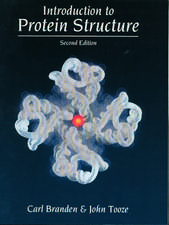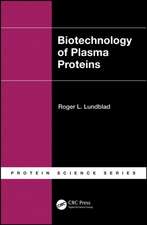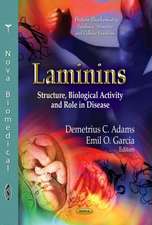NLR Proteins: Methods and Protocols: Methods in Molecular Biology, cartea 1417
Editat de Francesco Di Virgilio, Pablo Pelegrínen Limba Engleză Hardback – 25 mai 2016
This volume providesa sound basis for the molecular investigation of NLR function in health anddisease. Chapters focus on of innate immune receptors, “atypical”inflammasomes, biochemical and novel bioluminescencetechniques for the measurement of IL-1b,bioluminescent probe, biochemical and microscopytechniques, techniques to measure caspase-1 activation, cellfree systems for the study of inflammasome function, and inflammasomeactivation. Written in the highly successful Methodsin Molecular Biology series format, chapters include introductions to theirrespective topics, lists of the necessary materials and reagents, step-by-step,readily reproducible laboratory protocols, and tips on troubleshooting andavoiding known pitfalls.
Authoritativeand cutting-edge, NLR Proteins: Methodsand Protocols aims to ensure successful results in the further study ofthis vital field.
Authoritativeand cutting-edge, NLR Proteins: Methodsand Protocols aims to ensure successful results in the further study ofthis vital field.
| Toate formatele și edițiile | Preț | Express |
|---|---|---|
| Paperback (1) | 390.63 lei 6-8 săpt. | |
| Springer – 26 mai 2018 | 390.63 lei 6-8 săpt. | |
| Hardback (2) | 399.67 lei 6-8 săpt. | |
| Springer – 25 mai 2016 | 399.67 lei 6-8 săpt. | |
| Springer Us – 15 aug 2023 | 1119.71 lei 6-8 săpt. |
Din seria Methods in Molecular Biology
- 9%
 Preț: 791.59 lei
Preț: 791.59 lei - 23%
 Preț: 598.56 lei
Preț: 598.56 lei - 20%
 Preț: 882.95 lei
Preț: 882.95 lei -
 Preț: 252.04 lei
Preț: 252.04 lei - 5%
 Preț: 729.61 lei
Preț: 729.61 lei - 5%
 Preț: 731.43 lei
Preț: 731.43 lei - 5%
 Preț: 741.30 lei
Preț: 741.30 lei - 5%
 Preț: 747.16 lei
Preț: 747.16 lei - 15%
 Preț: 663.45 lei
Preț: 663.45 lei - 18%
 Preț: 1025.34 lei
Preț: 1025.34 lei - 5%
 Preț: 734.57 lei
Preț: 734.57 lei - 18%
 Preț: 914.20 lei
Preț: 914.20 lei - 15%
 Preț: 664.61 lei
Preț: 664.61 lei - 15%
 Preț: 654.12 lei
Preț: 654.12 lei - 18%
 Preț: 1414.74 lei
Preț: 1414.74 lei - 5%
 Preț: 742.60 lei
Preț: 742.60 lei - 20%
 Preț: 821.63 lei
Preț: 821.63 lei - 18%
 Preț: 972.30 lei
Preț: 972.30 lei - 15%
 Preț: 660.49 lei
Preț: 660.49 lei - 5%
 Preț: 738.41 lei
Preț: 738.41 lei - 18%
 Preț: 984.92 lei
Preț: 984.92 lei - 5%
 Preț: 733.29 lei
Preț: 733.29 lei -
 Preț: 392.58 lei
Preț: 392.58 lei - 5%
 Preț: 746.26 lei
Preț: 746.26 lei - 18%
 Preț: 962.66 lei
Preț: 962.66 lei - 23%
 Preț: 860.21 lei
Preț: 860.21 lei - 15%
 Preț: 652.64 lei
Preț: 652.64 lei - 5%
 Preț: 1055.50 lei
Preț: 1055.50 lei - 23%
 Preț: 883.85 lei
Preț: 883.85 lei - 19%
 Preț: 491.88 lei
Preț: 491.88 lei - 5%
 Preț: 1038.84 lei
Preț: 1038.84 lei - 5%
 Preț: 524.15 lei
Preț: 524.15 lei - 18%
 Preț: 2122.34 lei
Preț: 2122.34 lei - 5%
 Preț: 1299.23 lei
Preț: 1299.23 lei - 5%
 Preț: 1339.10 lei
Preț: 1339.10 lei - 18%
 Preț: 1390.26 lei
Preț: 1390.26 lei - 18%
 Preț: 1395.63 lei
Preț: 1395.63 lei - 18%
 Preț: 1129.65 lei
Preț: 1129.65 lei - 18%
 Preț: 1408.26 lei
Preț: 1408.26 lei - 18%
 Preț: 1124.92 lei
Preț: 1124.92 lei - 18%
 Preț: 966.27 lei
Preț: 966.27 lei - 5%
 Preț: 1299.99 lei
Preț: 1299.99 lei - 5%
 Preț: 1108.51 lei
Preț: 1108.51 lei - 5%
 Preț: 983.72 lei
Preț: 983.72 lei - 5%
 Preț: 728.16 lei
Preț: 728.16 lei - 18%
 Preț: 1118.62 lei
Preț: 1118.62 lei - 18%
 Preț: 955.25 lei
Preț: 955.25 lei - 5%
 Preț: 1035.60 lei
Preț: 1035.60 lei - 18%
 Preț: 1400.35 lei
Preț: 1400.35 lei - 20%
 Preț: 817.30 lei
Preț: 817.30 lei
Preț: 399.67 lei
Nou
Puncte Express: 600
Preț estimativ în valută:
76.48€ • 79.37$ • 63.93£
76.48€ • 79.37$ • 63.93£
Carte tipărită la comandă
Livrare economică 15-29 martie
Preluare comenzi: 021 569.72.76
Specificații
ISBN-13: 9781493935642
ISBN-10: 149393564X
Pagini: 235
Ilustrații: XI, 256 p. 52 illus., 43 illus. in color.
Dimensiuni: 178 x 254 x 16 mm
Greutate: 0.69 kg
Ediția:1st ed. 2016
Editura: Springer
Colecția Humana
Seria Methods in Molecular Biology
Locul publicării:New York, NY, United States
ISBN-10: 149393564X
Pagini: 235
Ilustrații: XI, 256 p. 52 illus., 43 illus. in color.
Dimensiuni: 178 x 254 x 16 mm
Greutate: 0.69 kg
Ediția:1st ed. 2016
Editura: Springer
Colecția Humana
Seria Methods in Molecular Biology
Locul publicării:New York, NY, United States
Public țintă
Professional/practitionerCuprins
Innate Immune Receptors.- Atypical Inflammasomes.- Assessment of Inflammasome Activation By Cytokine And Danger Signal Detection.- Investigating IL-1β Secretion Using Real-Time Single-Cell Imaging.- Measuring IL-1β Processing By Bioluminescence Sensors I: Using a Bioluminescence Resonance Energy Transfer Biosensor.- Measuring IL-1β Processing By Bioluminescence Sensors II: The Igluc System.- Assessing Extracellular ATP as Danger Signal In Vivo: The Pmeluc System.- Measuring NLR Oligomerization I: Size Exclusion Chromatography, Co-Immunoprecipitation and Cross-Linking.- Measuring NLR Oligomerization II: Detection of ASC Speck Formation by Confocal Microscopy and Immunofluorescence.- Measuring NLR Oligomerization III: Detection of NLRP3 Complex by Bioluminescence Resonance Energy Transfer.- Measuring NLR Oligomerization IV: Using Förster Resonance Energy Transfer (FRET)-Fluorescence Lifetime Imaging Microscopy (FLIM) to Determine the Close Proximity Of Inflammasome Components.- Measuring NLR Oligomerization V: In Situ Proximity Ligation Assay.- Assessing Caspase-1 Activation.- Cell-Free Assay for Inflammasome Activation.- Functional Reconstruction of Nlrs In HEK293 Cells.- Method to Measure Ubiquitinization of Nlrs.- Cytofluorometric Quantification of Cell Death Elicited By NLR Proteins.- NLR in Human Diseases: Role and Laboratory Findings.
Caracteristici
Includes cutting-edge methods and protocols Provides step-by-step detail essential for reproducible results Contains key notes and implementation advice from the experts
Textul de pe ultima copertă
This second edition provides a sound basis for the molecular investigation of NLR function in health and disease. Chapters focus on NLR as innate immune receptors, “atypical” inflammasomes, biochemical and novel bioluminescence techniques for the measurement of IL-1b as readout of NLR-based inflammasomes, bioluminescent probe, biochemical and microscopy techniques, techniques to measure caspase-1 activation, cell free systems for the study of inflammasome function, and inflammasome activation. Written in the highly successful Methods in Molecular Biology series format, chapters include introductions to their respective topics, lists of the necessary materials and reagents, step-by-step, readily reproducible laboratory protocols, and key tips on troubleshooting and avoiding known pitfalls.
Authoritative and cutting-edge, NLR Proteins: Methods and Protocols, Second Edition aims to be a useful and practical guide to new researcher sand experts looking to expand theirknowledge.
Authoritative and cutting-edge, NLR Proteins: Methods and Protocols, Second Edition aims to be a useful and practical guide to new researcher sand experts looking to expand theirknowledge.




















